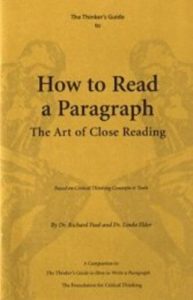This guide provides theory and activities necessary for deep comprehension. It is imminently practical for students. In this guide, the authors point out that skilled readers do not read blindly, but purposely. They have an agenda, goal, or objective. Their purpose, together with the nature of what they are reading, determines how they read. They read in different ways in different situations for different purposes. Of course, reading has a nearly universal purpose: to figure out what an author has to say on a given subject. How you read should be determined in part by what you read. Reflective readers read a textbook, for example, using a different mindset than they use when reading an article in a newspaper. Furthermore, reflective readers read a textbook in biology differently from the way they read a textbook in history. The reflective mind improves its thinking by reflectively thinking about it. Likewise, it improves its reading by reflectively thinking about how it is reading. It moves back and forth between the cognitive (thinking) and the meta-cognitive (thinking about thinking). It moves forward a bit, then loops back upon itself to check on its own operations. It checks its tracks. It makes good its ground. It rises above itself and exercises oversight on itself.
One of the most important abilities that a thinker can have is the ability to monitor and assess his or her own thinking while processing the thinking of others. In reading, the reflective mind monitors how it is reading while it is reading. The foundation for this ability is knowledge of how the mind functions when reading well. Having recognized this, we should also recognize that there are core reading tools and skills for reading any substantive text. These tools and skills are the focus of this guide.
One of the most important abilities that a thinker can have is the ability to monitor and assess his or her own thinking while processing the thinking of others. In reading, the reflective mind monitors how it is reading while it is reading. The foundation for this ability is knowledge of how the mind functions when reading well. Having recognized this, we should also recognize that there are core reading tools and skills for reading any substantive text. These tools and skills are the focus of this guide.






